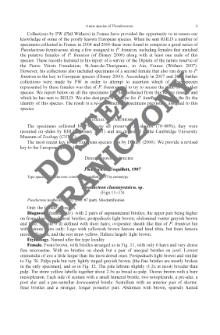- Search in all Repository
- Literature and maps
- Archeology
- Mills database
- Natural sciences
Advanced search
Advanced search
Advanced search
Advanced search
Advanced search

Object
Title: Biological collections as reference base for biodiversity assessement in the Republic of Korea
Creator:
Lee, Byung-Hoon ; Cho, Young Bok ; Lee, Eui-Hyeong ; Polska Akademia Nauk. Muzeum i Instytut Zoologii
Date issued/created:
Resource type:
Subtitle:
Fauna and Flora of the Korean Peninsula ; Kolekcje biologiczne jako baza oceniająca bioróżnorodność w Republice Korei ; Biological collections of Korea
Publisher:
Muzeum i Instytut Zoologii PAN
Place of publishing:
Description:
Zawiera materiały z konferencji: Polish-Korean Joint Seminar Fauna and Flora of the Korean Peninsula: Their Inventory, Systematics and Evolution in Perspective of Biodiversity Conservation ; W serii gł.: Fragmenta Faunistica, t. 40, nr 16 ; Bibliogr. p. 212 ; P. 207-213 : ill. ; 24 cm ; Abstract in Polish. Taxa in Latin.
Type of object:
Abstract:
Biological collections in 72 depositories of South Korea were surveyed. The number of specimens attained 5 144 409 in total, consisting of 4 103 000 animals, 1 034 825 plants and 6 584 fossils. The average numbers of specimens and species for each collection were 71 450 and 1 130 respectively. The most frequent were in the class range of 10 000-50 000 specimens and 0-100 species each. Twenty one of 45 depositories answered that 80% of their collections are well managed. As regards documentation, only 24% of the collections were electronically databased. The number of species represented by type specimens in the collections and taxonomic experts turned out to be 577 and 207 each. Considering the deplorable situation of the collection status, it is strongly suggested that immediate actions for capacity building by networking databases of the collections, man-power training and setting up of the National Museum of Natural History are urgently needed to provide resource base for biodiversity assessment as well as to respond properly to the Convention on Biological Diversity.
Relation:
Fragmenta Faunistica ; Fragmenta Faunistica. Fauna and Flora of the Korean Peninsula
Volume:
Issue:
Start page:
End page:
Detailed Resource Type:
Format:
Resource Identifier:
oai:rcin.org.pl:54430 ; 10.3161/00159301FF1997.40.16.207
Source:
MiIZ PAN, call no. P.256, T. 40 nr 16 ; MiIZ PAN, call no. P.4664, T. 40 nr 16 ; click here to follow the link
Language:
Rights:
Rights Reserved - Restricted Access
Terms of use:
Digitizing institution:
Museum and Institute of Zoology of the Polish Academy of Sciences
Original in:
Library of the Museum and Institute of Zoology of the Polish Academy of Sciences
Projects co-financed by:
Programme Innovative Economy, 2010-2014, Priority Axis 2. R&D infrastructure ; European Union. European Regional Development Fund
Access:
Object collections:
- Digital Repository of Scientific Institutes > Partners' collections > Museum and Institute of Zoology PAS > Scientific Journals
- Digital Repository of Scientific Institutes > Partners' collections > Museum and Institute of Zoology PAS > MIZ PAN Publications > Fragmenta Faunistica
- Digital Repository of Scientific Institutes > Literature > Journals/Articles
Last modified:
Feb 4, 2025
In our library since:
Jun 22, 2015
Number of object content downloads / hits:
74
All available object's versions:
https://rcin.org.pl./publication/60918
Show description in RDF format:
Show description in RDFa format:
Show description in OAI-PMH format:
Objects Similar
Trojan, Przemysław Wytwer, Jolanta Polska Akademia Nauk. Muzeum i Instytut Zoologii
Golovač, Sergej Il'ič (1952– ) Hoffman, Richard Lawrence (1927–2012) Polska Akademia Nauk. Muzeum i Instytut Zoologii International Congress of Myriapodology (11 ; 1999 ; Białowieża)
Bańkowska, Regina Sterzyńska, Maria Polska Akademia Nauk. Muzeum i Instytut Zoologii
Pawłowski, Jerzy Tomek, Teresa Polska Akademia Nauk. Muzeum i Instytut Zoologii.
Kwon, Yong Jung Huh, Eun Yeop Polska Akademia Nauk. Muzeum i Instytut Zoologii
Jarocki, Feliks Paweł (1790–1869)
Pawłowski, Jerzy Polska Akademia Nauk. Muzeum i Instytut Zoologii
Szeptycki, Andrzej (1939–2008) Polska Akademia Nauk. Muzeum i Instytut Zoologii

 INSTYTUT ARCHEOLOGII I ETNOLOGII POLSKIEJ AKADEMII NAUK
INSTYTUT ARCHEOLOGII I ETNOLOGII POLSKIEJ AKADEMII NAUK
 INSTYTUT BADAŃ LITERACKICH POLSKIEJ AKADEMII NAUK
INSTYTUT BADAŃ LITERACKICH POLSKIEJ AKADEMII NAUK
 INSTYTUT BADAWCZY LEŚNICTWA
INSTYTUT BADAWCZY LEŚNICTWA
 INSTYTUT BIOLOGII DOŚWIADCZALNEJ IM. MARCELEGO NENCKIEGO POLSKIEJ AKADEMII NAUK
INSTYTUT BIOLOGII DOŚWIADCZALNEJ IM. MARCELEGO NENCKIEGO POLSKIEJ AKADEMII NAUK
 INSTYTUT BIOLOGII SSAKÓW POLSKIEJ AKADEMII NAUK
INSTYTUT BIOLOGII SSAKÓW POLSKIEJ AKADEMII NAUK
 INSTYTUT CHEMII FIZYCZNEJ PAN
INSTYTUT CHEMII FIZYCZNEJ PAN
 INSTYTUT CHEMII ORGANICZNEJ PAN
INSTYTUT CHEMII ORGANICZNEJ PAN
 INSTYTUT FILOZOFII I SOCJOLOGII PAN
INSTYTUT FILOZOFII I SOCJOLOGII PAN
 INSTYTUT GEOGRAFII I PRZESTRZENNEGO ZAGOSPODAROWANIA PAN
INSTYTUT GEOGRAFII I PRZESTRZENNEGO ZAGOSPODAROWANIA PAN
 INSTYTUT HISTORII im. TADEUSZA MANTEUFFLA POLSKIEJ AKADEMII NAUK
INSTYTUT HISTORII im. TADEUSZA MANTEUFFLA POLSKIEJ AKADEMII NAUK
 INSTYTUT JĘZYKA POLSKIEGO POLSKIEJ AKADEMII NAUK
INSTYTUT JĘZYKA POLSKIEGO POLSKIEJ AKADEMII NAUK
 INSTYTUT MATEMATYCZNY PAN
INSTYTUT MATEMATYCZNY PAN
 INSTYTUT MEDYCYNY DOŚWIADCZALNEJ I KLINICZNEJ IM.MIROSŁAWA MOSSAKOWSKIEGO POLSKIEJ AKADEMII NAUK
INSTYTUT MEDYCYNY DOŚWIADCZALNEJ I KLINICZNEJ IM.MIROSŁAWA MOSSAKOWSKIEGO POLSKIEJ AKADEMII NAUK
 INSTYTUT PODSTAWOWYCH PROBLEMÓW TECHNIKI PAN
INSTYTUT PODSTAWOWYCH PROBLEMÓW TECHNIKI PAN
 INSTYTUT SLAWISTYKI PAN
INSTYTUT SLAWISTYKI PAN
 SIEĆ BADAWCZA ŁUKASIEWICZ - INSTYTUT TECHNOLOGII MATERIAŁÓW ELEKTRONICZNYCH
SIEĆ BADAWCZA ŁUKASIEWICZ - INSTYTUT TECHNOLOGII MATERIAŁÓW ELEKTRONICZNYCH
 MUZEUM I INSTYTUT ZOOLOGII POLSKIEJ AKADEMII NAUK
MUZEUM I INSTYTUT ZOOLOGII POLSKIEJ AKADEMII NAUK
 INSTYTUT BADAŃ SYSTEMOWYCH PAN
INSTYTUT BADAŃ SYSTEMOWYCH PAN
 INSTYTUT BOTANIKI IM. WŁADYSŁAWA SZAFERA POLSKIEJ AKADEMII NAUK
INSTYTUT BOTANIKI IM. WŁADYSŁAWA SZAFERA POLSKIEJ AKADEMII NAUK




































